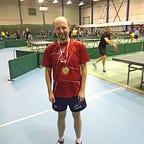Video analyse of a match
Yesterday, my trainer gave me a tough critic of one of my match. It was a match that I personally thought wasn't that bad considering the context. Fortunately this match was filmed, so I could watch it myself again.
This second look confirmed my first impression: While there were lots of improvements, it wasn’t that bad, and how I played had reasons behind it.
Here is the match: https://www.youtube.com/live/RyLmNoXVkVQ?feature=share&t=12852
Context
Often what happened in previous matches and in previous competitions will affect heavily how you play. This was clearly the case here, as:
- On the previous day, I played another competition that didn’t go well. The last 4 matches in particular were a nightmare. I left that competition with low motivation and lots of doubts. Therefore my primary goal for that next day was to try to feel better and rebuilt part of my mental.
- On the previous TT Cup, I served very badly. In between I practiced and identified what was wrong with my serves. So my secondary objective was to serve much better.
- Finally, I played the same player earlier that day and lost because in first two sets, I really struggled to return his serves.
Numbers
Let’s look at numbers first. One good thing about TT-Cup is that we get some small statistics on the match, in particular the percentage of points won on serves and returns. On a side note, I would love to have a bit more detailed statistics, for example the percentage per set, or how this percentage changes through the match.
I won the match 3–2. The two sets I lost were 10–12. I missed winning them due to various circumstances, but especially the 4th set should have been mine. The sets I won were with a more convincing (8, 9, 5). In total I won 53 points to 46 for my opponents.
On my serve I won 61% of the points, which I feel is a fair number.
Serving
The one thing my trainer reproached me is that I should have used more long backspin into the backhand serves. Her point was that since he was pushing them I could then topspin the 3rd ball. In general it’s true, but it doesn’t take into account that because of the context, I wasn’t in high enough confidence to perform such a combination. My feeling was that it wouldn’t have been a setup that, for me, on that day, would have won me a lot of points.
Instead, I tried to vary more my serves and use the ones that were causing him troubles. For example, the reverse pendulum with backspin into his forehand was very efficient (he missed all but one). The fast reverse pendulum into the backhand worked as well, as did the fast sidespin serve into the middle. On simpler backspin serves, I got back pushes usually, which I tended to push back until an easier attack opportunity came.
A clear problem: Replacement after serve
The main problem I saw in the video was my replacement after the serve, especially after the reverse pendulum one. After the serve I fall forward and get into a bad placement that forces me to play a backhand.
Here is an example:
And after the serve:
Videos are very useful to understand problems in your game. In this specific example, I watched part of the match a second time, focusing on my replacement. Interestingly, I observed that in some case my replacement is fine, and in others it’s bad as pictured above.
And then I realized what was the difference!
There are some serves where I know I will get a good higher or longer ball. I know I will feel good about attacking this ball, such as with all the topspin serves. In such cases, my placement is better and I can attack the balls fine most of the time. There are other serves however where I haven’t developed the habit of attacking them. The reverse pendulum with backspin is a good example. Without the habit, I move into passive defensive position, which in my case turns out to be a pretty bad one, with right leg in front (that position makes basically any good forehand impossible).
So it seems the fix is not really to worry about my replacement, but instead focus on wanting to attack all those serves. Let’s try that!
Returns
As I wrote, in the previous match I returned really badly his serves into my backhand. They were long and with spin, so a push was risky and I had to top-spin them. But initially I struggled with my timing.
In the second match it was much better. I still did mistakes, but I understood fairly clearly why those happened so I was able to avoid repeating them.
The key for returning these serves with my backhand was to take the ball early enough, not let it fall. I wanted to take it on top of the bounce and cleanly pass above the ball. It was also important to go forward. So I made sure to:
- Stand close enough to the table.
- Be ready, by starting to move my legs a bit before his serve.
- Repeat myself to be courageous, so that I return positively and aggressively.
The improvements I did for the second match are a great satisfaction of that day. In the past, when a serve caused me problems it often made my whole game crumble. Here however I kept my composure, looked and found a solution. It was the key difference that changed a 0–3 loss into a win.
Conclusion
Initially I hadn’t planned to watch the video of my game, because I didn’t feel it was that interesting. The comments of my trainer, which I considered unfair, made me rewatch it and it turns out I learned something important about by post-serve replacement.
